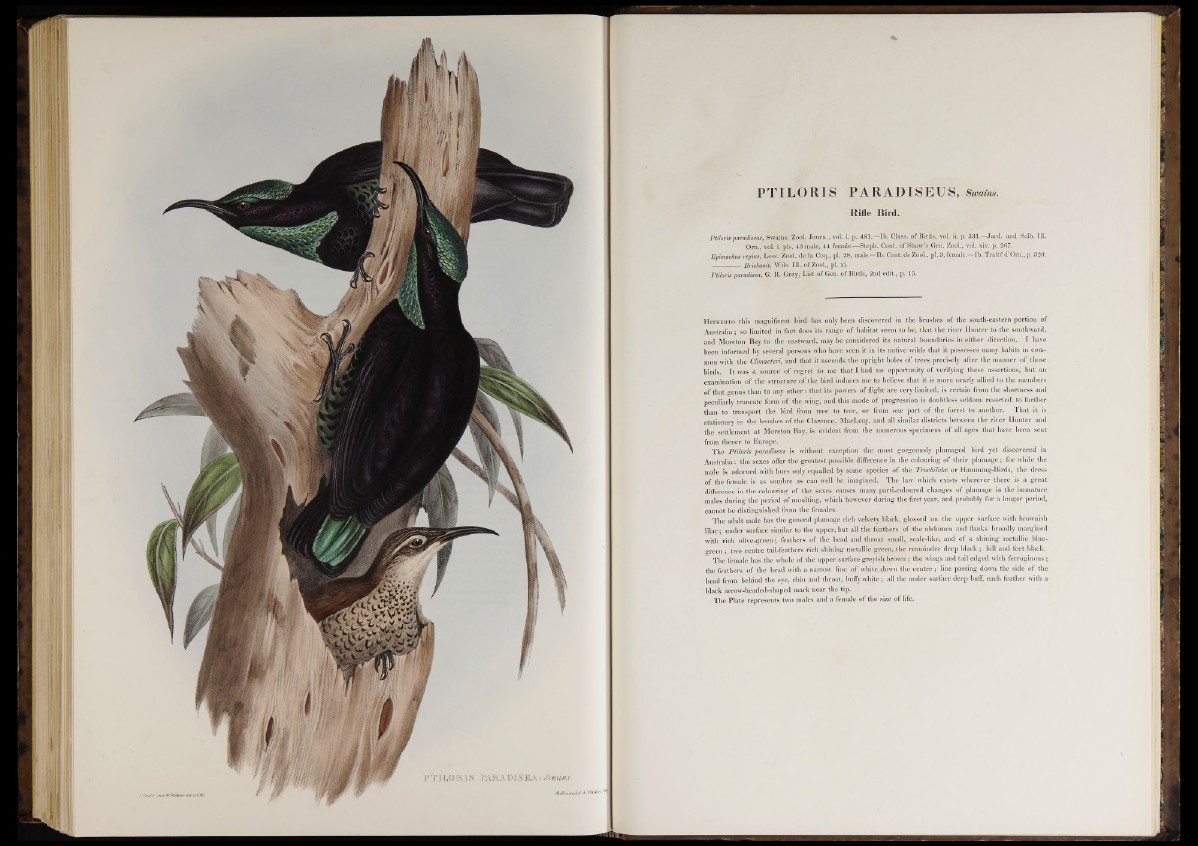
Ht
PTILORIS PARADISEUS, Swains.
Rifle Bird.
Ptiloris paradiseus, Swains. Zool. Jouta., vol. i. p. 481.—Ib. Class, of Birds, vol. ii. p. 331.—Jard. and Selb. 111.
Om., vol. i. pis. 43 male, 44 female.—Stepb. Cont. of Shaw’s Gen. Zool., vol. xiv. p. 267.
Epimachus repus, Less. Zool. de la Coq., pi. 28, male.—Ib. Cent, de Zool., pi. 3, female.—Ib. Traité d’Orn., p. 320.
------------- Brisbanii, Wils. 111. of Zool., pi. xi.
Ptiloris paradisea, G. R. Gray, List of Gen. of Birds, 2nd edit., p. 15.
H it h e r t o this magnificent bird has only been discovered in the brushes of the south-eastern portiou of
Australia • so limited in fact does its range of habitat seem to be, that the river Hunter to the southward,
and Moreton Bay to the eastward, may be considered its natural boundaries in either direction. I have
been informed by several persons who have seen it in its native wilds that it possesses many habits in common
with the Climacteri, and that it ascends the upright boles of trees precisely after the manner o f those
birds. It was a source of regret to me that I had no opportunity of verifying these assertions, but an
examination of the structure of the bird induces me to believe that it is more nearly allied to the members
of that genus than to any other: that its powers of flight are very limited, is certain from the shortness and
peculiarly truncate form of the wing, and this mode of progression is doubtless seldom resorted to further
than to transport the bird from tree to tree, or from one part of the forest to another. That it is
stationary in the brushes of the Clarence, MacLeay, and all similar districts between the river Hunter and
the settlement at Moreton Bay, is evident from the numerous specimens of all ages that have been sent
from thence to Europe.
The Ptiloris paradiseus is without exception the most gorgeously plumaged bird yet discovered in
Australia: the sexes offer the greatest possible difference in the colouring o f their plumage; for while the
male is adorned with hues only equalled by some species of the Trochilidce or Humming-Birds, the dress
o f the female is as sombre as can well be imagined. The law which exists wherever there is a great
difference in the colouring of the sexes causes many parti-coloured changes of plumage in the immature
males during the period of moulting, which however during the first year, and probably for a longer period,
cannot be distinguished from the females.
The adult male has the general plumage rich velvety black, glossed on the upper surface with brownish
lilac • under surface similar to the upper, but all the feathers of the abdomen and flanks broadly margined
with rich olive-oreen; feathers of the head and throat small, scale-like, and of a shining metallic blue-
green ; two centre tail-feathers rich shining metallic green, the remainder deep black; bill and feet black.
The female has the whole of the upper surface greyish: brown ; the wings and tail edged with ferruginous;
the feathers of the head with a narrow line of white,down the centre ; line passing down the side of the
head from behind the eye, chin and throat, buffy white; all the under surface deep buff, each feather with a
black arrow-headed-shaped mark near the tip.
The Plate represents two males and a female of the size of life.